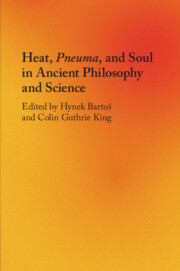Book contents
- Heat, Pneuma, and Soul in Ancient Philosophy and Science
- Heat, Pneuma, and Soul in Ancient Philosophy and Science
- Copyright page
- Contents
- Contributors
- Preface
- Introduction
- I Early Greek Philosophy and Medicine
- II Aristotle
- Chapter 7 Heat, Meteorology, and Spontaneous Generation
- Chapter 8 Aristotle on the Nature in the Pneuma and the First Body
- Chapter 9 Aristotle on the Powers of Thermic Equilibrium
- Chapter 10 Why Animals Must Keep Their Cool: Aristotle on the Need for Respiration (and Other Forms of Cooling)
- Chapter 11 Soul’s Tools
- Chapter 12 When Life Imitates Art: Vital Locomotion and Aristotle’s Craft Analogy
- Chapter 13 Blood, Pneuma, or Something More Solid? Aristotle on the Material Structure of Perceptual Apparatus
- Chapter 14 The Pathological Role of Pneuma in Aristotle
- Bibliography
- Index Locorum
- Index
Chapter 8 - Aristotle on the Nature in the Pneuma and the First Body
from II - Aristotle
Published online by Cambridge University Press: 20 February 2020
- Heat, Pneuma, and Soul in Ancient Philosophy and Science
- Heat, Pneuma, and Soul in Ancient Philosophy and Science
- Copyright page
- Contents
- Contributors
- Preface
- Introduction
- I Early Greek Philosophy and Medicine
- II Aristotle
- Chapter 7 Heat, Meteorology, and Spontaneous Generation
- Chapter 8 Aristotle on the Nature in the Pneuma and the First Body
- Chapter 9 Aristotle on the Powers of Thermic Equilibrium
- Chapter 10 Why Animals Must Keep Their Cool: Aristotle on the Need for Respiration (and Other Forms of Cooling)
- Chapter 11 Soul’s Tools
- Chapter 12 When Life Imitates Art: Vital Locomotion and Aristotle’s Craft Analogy
- Chapter 13 Blood, Pneuma, or Something More Solid? Aristotle on the Material Structure of Perceptual Apparatus
- Chapter 14 The Pathological Role of Pneuma in Aristotle
- Bibliography
- Index Locorum
- Index
Summary
Thein provides a detailed analysis of Aristotle’s analogy between “the phusis in the pneuma” and “the element of the stars” in Aristotle’s GA (736b29–737a7). With the help of several passages in GA which discuss the role of pneuma in the generation of living beings, as well as passages of De caelo, where the first body is presented as an animate, self-moving but soulless entity, Thein makes the case that the key to the analogy lies in the shared link between motion and animation, a link which, in these two cases only, does not require the actual presence of the soul.
- Type
- Chapter
- Information
- Heat, Pneuma, and Soul in Ancient Philosophy and Science , pp. 182 - 201Publisher: Cambridge University PressPrint publication year: 2020
- 1
- Cited by

